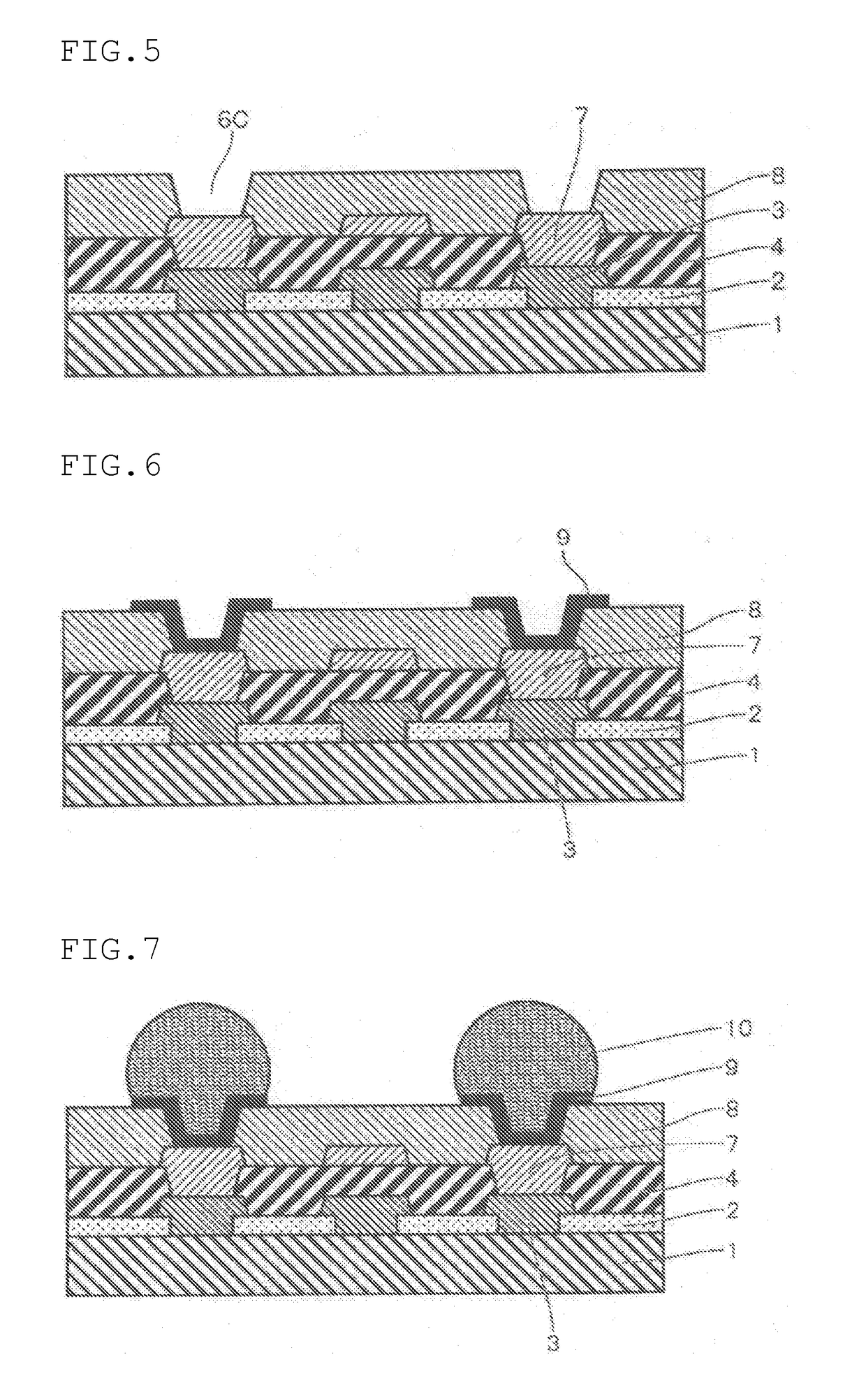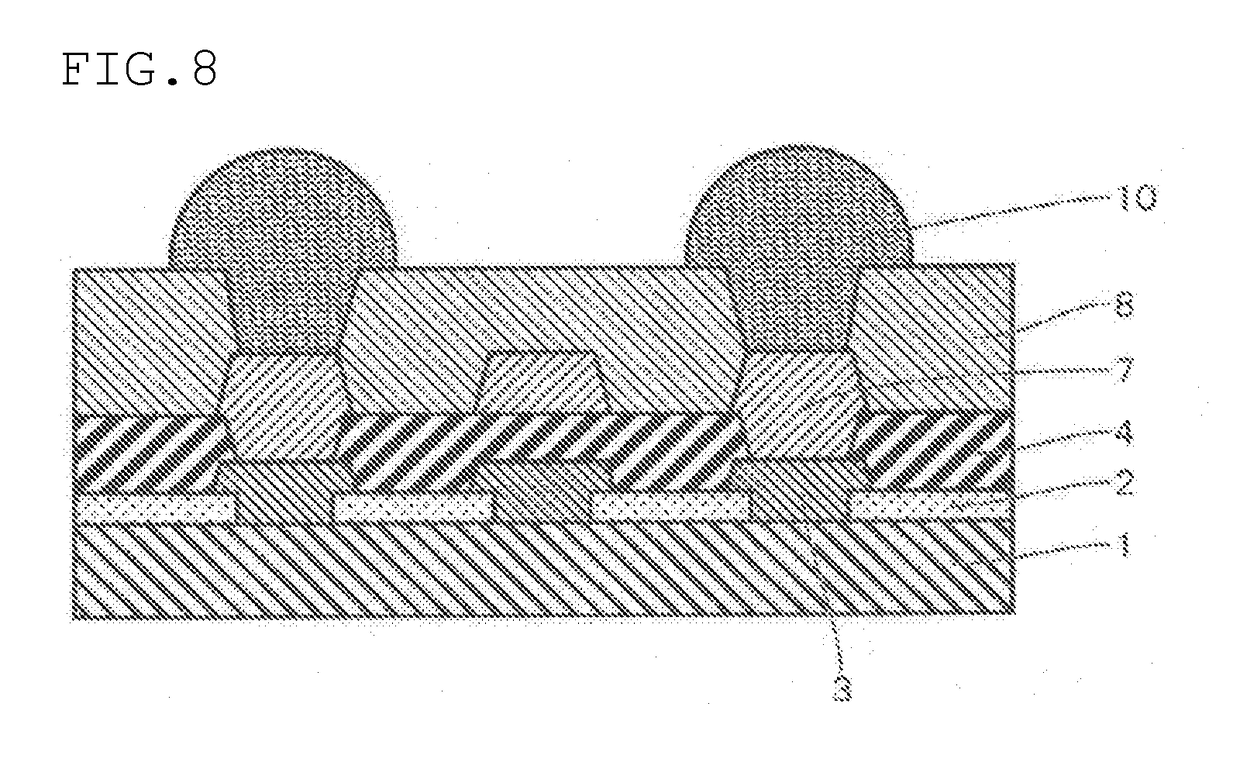Positive-type photosensitive resin composition
a technology of photosensitive resin and composition, which is applied in the direction of photomechanical treatment, photomechanical equipment, instruments, etc., can solve the problems of deteriorating adhesion properties and unreacted crosslinking agents, and achieve the effect of satisfying adhesion properties
- Summary
- Abstract
- Description
- Claims
- Application Information
AI Technical Summary
Benefits of technology
Problems solved by technology
Method used
Image
Examples
synthesis example 1
[0111]60 g of N-methylpyrrolidone was fed into a flask of 0.2 liters equipped with a stirrer and a thermometer, and 13.92 g (38 mmol) of 2,2-bis (3-amino-4-hydroxyphenyl) hexafluoropropane was added and dissolved by stirring. Further, while the temperature was maintained at 0 to 5° C., 10.69 g (40 mmol) of dodecanedioic acid dichloride was dropped for 10 minutes, and then the solution in the flask was stirred for 60 minutes. The above-described solution was poured into 3 liters of water, a precipitate was collected, and a resultant product was washed with pure water three times and then depressurized, whereby polyhydroxyamide (polybenzoxazole precursor) was obtained (hereinafter, referred to as a polymer I). The weight average molecular weight of the polymer I was 33,100, and the dispersity thereof was 2.0. The weight average molecular weight was found by gel permeation chromatography (GPC) in terms of standard polystyrene.
[0112]Measurement conditions of the weight average molecular...
synthesis example 2
[0113]10.69 g (40 mmol) of dodecanedioic acid dichloride used in Synthesis Example 1 was replaced by 7.48 g (28 mmol) of decanedioic acid dichloride and 3.56 g (12 mmol) of 4,4′-diphenylether dicarboxylic acid dichloride. Except for the above, synthesis was conducted as in Synthesis Example 1, and polyhydroxyamide was obtained (hereinafter, referred to as a polymer II). The weight average molecular weight of the polymer II was 41,800, and the dispersity thereof was 2.0.
synthesis example 3
[0114]60 g of N-methylpyrrolidone was fed into a flask of 0.2 liters equipped with a stirrer and a thermometer, and 13.92 g (38 mmol) of 2,2-bis (3-amino-4-hydroxyphenyl) hexafluoropropane was added and dissolved by stirring. Then, while the temperature was maintained at 0 to 5° C., 11.86 g (40 mmol) of 4,4′-diphenylether dicarboxylic acid dichloride was dropped for 10 minutes. Thereafter, the temperature was returned to room temperature, and the solution in the flask was stirred for 3 hours. The above-described solution was poured into 3 liters of water, a precipitate was collected, and a resultant product was washed with pure water three times and then depressurized, whereby polyhydroxyamide was obtained (hereinafter, referred to as a polymer III). The weight average molecular weight of the polymer III was 22,400, and the dispersity thereof was 3.2.
PUM
| Property | Measurement | Unit |
|---|---|---|
| temperature | aaaaa | aaaaa |
| temperature | aaaaa | aaaaa |
| thickness | aaaaa | aaaaa |
Abstract
Description
Claims
Application Information
 Login to View More
Login to View More - R&D
- Intellectual Property
- Life Sciences
- Materials
- Tech Scout
- Unparalleled Data Quality
- Higher Quality Content
- 60% Fewer Hallucinations
Browse by: Latest US Patents, China's latest patents, Technical Efficacy Thesaurus, Application Domain, Technology Topic, Popular Technical Reports.
© 2025 PatSnap. All rights reserved.Legal|Privacy policy|Modern Slavery Act Transparency Statement|Sitemap|About US| Contact US: help@patsnap.com



